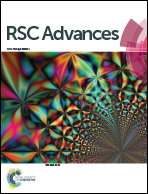Probing nanomechanical properties with AFM to understand the structure and behavior of polymer blends compatibilized with ionic liquids
Abstract
The PeakForce QNM AFM mode was used to investigate the nanoscale mechanical properties of poly(butylene-adipate-co-terephthalate)/poly(lactic acid) (PBAT/PLA) blends successfully compatibilized with phosphonium-based ionic liquids (ILs). This novel AFM mode allowed identification of the phase structuration and also emphasized the effect of the ionic liquids on the mechanical behavior at nanoscale of the polymer phases and interfaces. On one hand, phosphonium-chloride IL (il-Cl) was shown to play an efficient role as an interfacial agent, i.e., causing a finer dispersion of PLA nodules in the PBAT continuous matrix. On the other hand, phosphonium-phosphinate IL (il-TMP), leads to PLA dispersed as a fibril phase and located as an interphase layer between the two polymers. Adhesion force mappings confirmed that the ILs are mainly localized at the interfaces between the two polyesters. The PeakForce QNM AFM study allowed the proposal of complete models for the compatibilization mechanism, establishing relationships between the nanoscale structure and the macroscopic mechanical properties of these blends.


 Please wait while we load your content...
Please wait while we load your content...